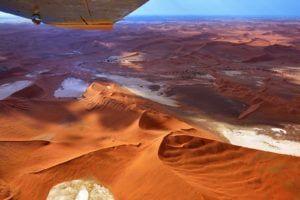Namibia’s Namib Desert is one of the most spectacular places we visit. Here’s why it’s one of the country’s most coveted attractions.
 10 Intriguing Facts About the Namib Desert
10 Intriguing Facts About the Namib Desert
- At 55-million-years of age, its believed to be the world’s most ancient deserts and one of the driest. Some areas receive less than 10mm (0.4”) of rain each year.
- Covering an area of 81,000 km² (50,000 mi²) and stretching more than 2,000 kilometers (1,200 miles) along the Atlantic coasts of Angola, Namibia, and South Africa, it’s the world’s 23rd-largest desert by area (larger than Switzerland).
- Temperatures along the coast are stable and range between 9-20ºC (48-68ºF) annually. They vary more as you move inland where summer daytime temps can reach 60°C during the day and drop below 0°C at night.
- Some of the world’s tallest sand dunes (over 300m) are found in the Namib Desert.
- Approximately 3,500 species of plants are found here, about half of which are endemic. Bizarre plants, innovative insects, and mammals with their own cooling systems have evolved to eke out an existence here.
- Fog, which creates dew, is the Namib’s primary source of water. There is also a permanent underground waterflow in spite of surface rivers being parched. Plants, reptiles, and mammals have adapted to survive with limited water supplies.
- Camelthorn trees are found throughout the desert. Remains of fossilized trees in Deadvlei, prevented from rotting by the extreme dryness, date back over 900 years. Their huge thorns prevent overgrazing and deep roots tap into underground water sources. Seeds only germinate once they’ve passed through the digestive tract of an animal.
- Desert-adapted elephants can go up to four days without drinking. Their wide feet facilitate walking on soft desert sand, useful for walking up to 60 km (37 miles) between water sources. They’ve also learned to dig waterholes with their tusks.
- The one-of-a-kind welwitschia plant grows only two leaves throughout its (up to) 1,500-year lifetime, each leaf measuring up to 4 meters (13 feet). The pre-historic-looking welwitschia is believed to date back to the Jurassic period.
- Sossusvlei, in the southern part of the Namib Desert, is a salt and clay ‘pan’ surrounded by sand dunes. Due to its unique red sand, Sossusvlei is a must-see for many people when travelling to Africa. A visit here is included in our Spectacular South West Africa and Victoria Falls to Cape Town trips, and as an optional excursion before the Waterfalls and Wildlife trip.
Although large parts of this desert region are protected, it still faces threats from unsustainable land practices, mining, and illegal plant harvesting.

